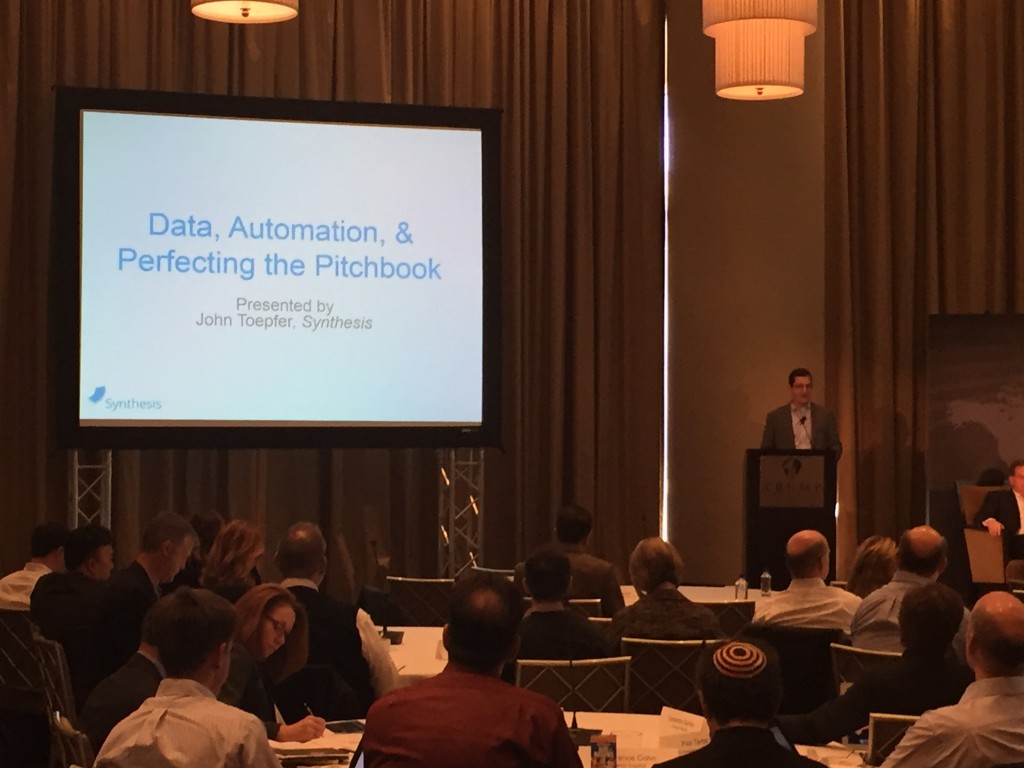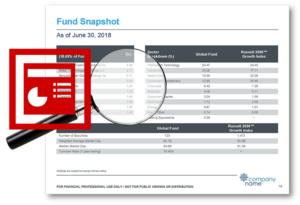CEO Talks: Leveraging Data to Create Customer-Centric Pitchbooks

Last month, our CEO, John Toepfer, was invited to speak at the Financial Technology Forum (FTF) held at Trump Tower in Chicago. This two-day event brought together CTO-level executives from Asset Management firms to discuss the issues around pitchbook automation, vendor management, CRM integration, data governance, and other IT-related topics. The Financial Technology Forum events are a division of Institutional Investor and held bi-annually for its members.
Mr. Toepfer was invited to speak on an expert panel for the session, “Automating Institutional Marketing” held on day two of the event. In this session, three guest speakers discussed the challenges of gathering and using intelligence on institutional investor activity, automating pitchbooks, and understanding why institutional sales efforts succeed or fail. All three panelists presented case studies on pitchbook automation to illustrate how firms are automating these processes.
The following is a summary of Toepfer’s portion of the presentation, “Data, Automation, and Perfecting the Pitchbook.” In his presentation, he talks about the importance of the data management and how it is the key driver of the overall success of a pitchbook automaton initiative.
What types of pitchbooks are most commonly automated?
1 – Prospect Decks
In our experience, there are two types of presentations that usually get automated. The first is what we often refer to as a prospect deck; a presentation used when a firm is in asset acquisition mode. The goal with this presentation is to gain new accounts and move new money into the organization. In a lot of cases these pitchbooks are fairly product-focused. The product-focused firms are typically large mutual-fund based companies. Pitchbooks produced by Hedge funds and institutionally-focused firms will present more complex information like strategies and portfolios containing multiple products.
2 – Account Reviews
The second type of presentation we see is account review material. This is where the firm is giving a review of an account and updating the client on what’s going on with their product and how the market is impacting or affecting the money that has been placed with the firm.
Trends in pitchbook strategies
Automation of standard product decks
Some of our investment management clients have dozens, if not hundreds of products for which they are trying to prepare sales materials. In doing so, they’re making sure that these materials are up to date and effectively presenting the information about their products and services. We see a surprising number of marketing departments who are still operating manually; working in PowerPoint and typing as fast they can to update the decks monthly and quarterly. Everybody realizes that is not an effective use of human talent. They also realize that moving data and product information into presentations manually is time intensive and error-prone. As a result, automation of sales and marketing materials are becoming a bigger focus for asset managers.
Dynamic Customization of Decks
Once you have the ability to move the data into a presentation automatically, it opens up the door to deliver more personalized materials, instead of relying on stock presentation material. It allows the sales force to customize their message to the specific audience and their specific needs. Automation gives investment sales teams access to stock material that’s been updated in an automated manner, and provides a mix and match capability to put together the right deck, for the right audience. It also allows access controls to provide the right materials to the right sales person. Not every sales person is qualified to sell every product under an umbrella, so you need to control what each salesperson has access to, and in what markets or regions. There are a lot of ins and outs on custom deck presentation.
Portfolio Proposal Decks
The most extreme case of custom deck presentation is what we call custom portfolio proposal decks. There are a few firms we work with who want the ability to propose a strategy, SMA, or a custom proposal for an institutional account with a blended account balance. Essentially, they want to take a basket of funds, or investments or strategies, and put them together in a single deck, not just a repetitive walk-thru of each product. This requires blending the data sets together so that a salesperson can show hypothetical projections and risks when products are blended in a certain way. The goal is to compile really clear data visualizations for clients. This is something that a small number of our clients are doing, but more are taking an interest. There are very interesting compliance and regulatory concerns when you start blending the data sets like this, but it is something that is seen as a forward looking target for a number of marketing organizations that we serve.
Data is the key
All of the above trends are supportable with technology. Behind all of these strategies to improve the pitch book production process—is data. Those of us on the IT side of the operation understand that data underlays everything about the types of products that we’re selling. Therefore, communication about the products requires a system that composes a deck, or stitches together a set of slides. There are a variety of vendor and homegrown solutions that can accomplish this. But, being able to merge this system with data and let the data flow through the process very smoothly and cleanly is the key behind achieving the full pitchbook goal.
So the key is the availability of data to support the strategy. You have to identify the data source for all of the data and standardize the process of moving the data through your data quality control system and clearing house. Then, you need a tool that is focused on supporting the data. There are a variety of presentation tools out there that are creative or collaborative in their orientation. In this market, what we find is that that the creativity comes in from marketing message and branding standpoint. From the sales standpoint, the goal is to make sure that the material is accurate, consistent and compliant with both regulatory and internal controls for the material. Of course you also need a tool that can build beautiful charts and graphs based on the data that has flown through the process. Again, data underlies everything.
The data scenario
Historically
We’ve been in this business for seventeen years, so when we started back in 1998, basically every financial services company was run on Excel. We were aggregating 40, 50, or 60 different Excel source files just to support production of the marketing and sales literature. We learned very quickly that we should not expect a client to have a clean data warehouse, or for data to work smoothly and perfectly from the get go. We had to provide that set of services. This has changed somewhat over time.
Today’s Situation
Most companies we speak to today have a data warehouse in place that is fairly up to date, but it’s only supporting approximately 70-80 percent of the data. This leaves the marketing group, or whoever is preparing the sales and marketing collateral, with the job of aggregating, cleaning up, and delivering the last 20-30 percent of the data into the process. This last 20-30 percent is usually the difficult data, not the data coming through a clean source. (For example, third party non-prop or other vendor-supplied data.) Either way, this leaves the marketing department in charge of handling data more than is desirable, and this 80/20 rule is what most companies have in terms of data to support the marketing processes. This leaves the marketing group worrying about data instead of focusing on their core deliverables.
Common data challenges
The Data Warehouse is Operationally Focus, Not Marketing Focused
Most of the data warehouses we deal with are successful when you think of the operational data needs of the organization. However, the reporting needs of the operation are usually less optimized. The data has been stored in a manner that is convenient from a delivery standpoint or research standpoint, but it’s not in a clean and publicly addressable format. We hear war stories from the marketing department about having access to a data warehouse, but lacking the clarity around when data was updated, or exactly which column of the performance data is appropriate for public disclosure. These pitfalls in the system create data problems for the marketing team.
Non-Data Warehouse Files are a Problem for the Marketing Team
When 20 percent of files are manual, this data can impede the effort of preparing pitch books because there are speed-to-market, data quality, and consistency issues that the marketing department is forced to deal with. Sometimes we find interesting scenarios where the data warehouse may be storing benchmark data, but then the benchmark data is also flowing through a FactSet data feed into the marketing department, and those numbers are just slightly off. What’s becoming a huge matter of importance, from a compliance standpoint, is making sure that we are extremely consistent with the data points that are being presented in all forms of marketing literature.
Data Consistency is a Problem
The website, pitch books, fact sheets, commentaries—everything has to be consistent. In our experience, we often find ourselves helping the marketing department track-down and figure out the difference between two basis points, because data was produced differently from two different processes. Someone has to decide which data point will be used in the marketing and sales collateral.
How to Support Custom Exhibits
When it comes to automating marketing for institutional and SMA/private wealth management, there is a need to support one-off or custom exhibits. Often times, the marketing team has provided a beautiful pitch book to present the product details, but an executive or partner in the firm wants to use a custom illustration to describe the product as he or she sees fit. This gets to the heart of why the product is valuable in today’s market. Making that happen in a clean manner is a huge challenge to the marketing organization, because they often don’t have the data or the tool, and they need to blend that custom slide into something that is otherwise highly automated.
Solution strategies
A successful pitchbook automation solution will be as adept at data handling, data composition, and data publishing as it is at slide assembly and access control. All things go together, but you have to make sure that you’re looking at a tool that is really proficient at handling data.
A data-capable pitchbook automation solution does not have to be a threat to the data warehouse. It should augment and enhance what you’re doing with data controls so that you have all data coming through a controlled process. Then, if handled well, the two data warehouses (and, yes, sometimes three data warehouses) are operating well. Each one can be a source and a master of a certain set of data, and they can coexist and exchange data in a clean ETL-driven process.
The data capable pitch book solution should not be a threat to the client’s data warehouse. Sometimes, we find that the IT organization stands in opposition of data moving in any direction, other than through the central data warehouse, and into the marketing organization. This can really impede the goals that marketing and sales have set up because sometimes the IT organization can’t quite move as quickly or nimbly as the market is dictating. So what we like to offer is the ability to let the marketing department do what they need to do to move quickly through their problems, but develop a solution that coexists very well with the internal initiatives, allowing good control of your own data sets.
Conclusion: What is the desired result from the principals involved?
As a Marketer
For the marketing department, we want a clean process with little or no manual data handling. Obviously, anytime a human being is touching data, it’s a risk from a compliance control and quality standpoint. The data should be made available to the marketing organization in a presentation-ready manner, so that they don’t have to worry about rounding, truncating, and calculating. It’s just a manner of publishing and thoughtfulness about presenting the marketing message. All presented data needs to be consistent, so we that the website matches the pitch book, which matches the fact sheet.
As an IT Organization
From the perspective of an IT organization, we want all the data to find its way back into the data warehouse with no manual effort. This doesn’t necessarily mean that it has to flow through in one direction to the warehouse, but it has to get there at the end of the day. We want the data sources and hand-offs to be completely auditable, so we know exactly where the data was, how it got transformed, how it got handled at all points in its lifecycle. Again, we want all presented data to be consistent.
As a Salesperson
Finally, from the sales perspective, we want all the material to be timely, especially the stock material. I just need to talk about “product x”. I need to make sure that deck is available for me three days after quarter end, or five days after quarter end, whatever the number is. Again, we want all presented data to be consistent, and we want the ability to customize these pitch books in a timely manner, without running afoul of any quality or compliance controls.







 Compare the Top 3 Finserv Content Automation Vendors [White paper]
Compare the Top 3 Finserv Content Automation Vendors [White paper] Create Pitchbooks the Drive Sales [White paper]
Create Pitchbooks the Drive Sales [White paper] Build vs. Buy: Should Your Financial Services Firm Outsource or Insource Marketing Technology? [White paper]
Build vs. Buy: Should Your Financial Services Firm Outsource or Insource Marketing Technology? [White paper]  10 Tips for Rebranding your Fund Marketing Documents [White paper]
10 Tips for Rebranding your Fund Marketing Documents [White paper]

